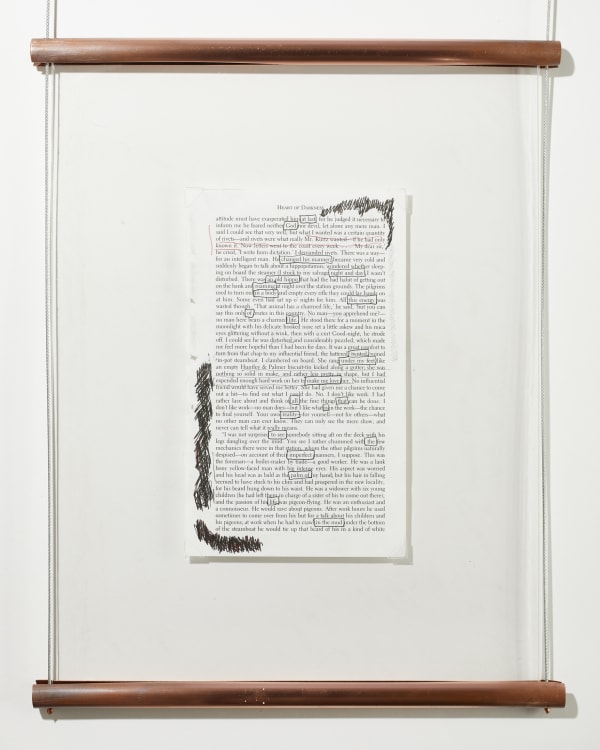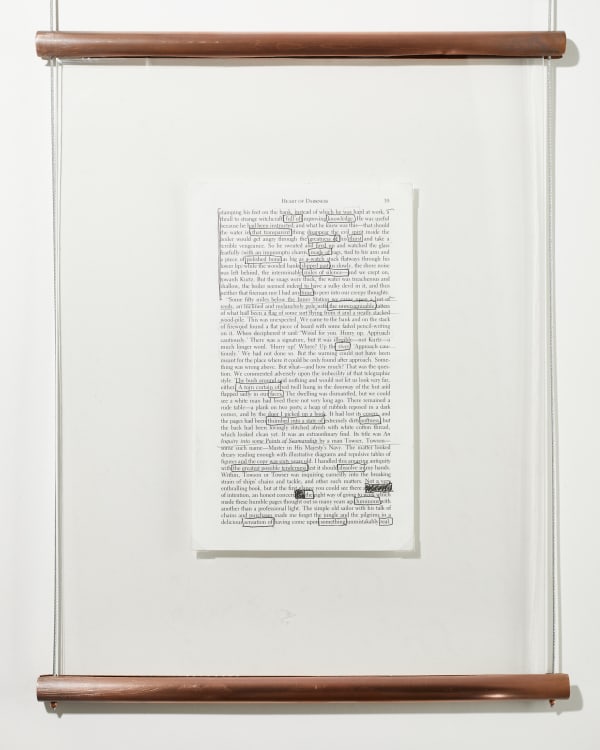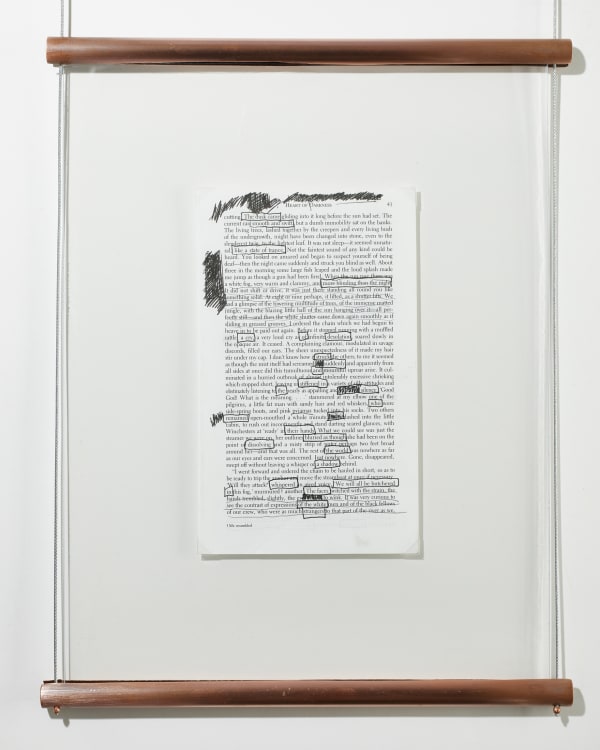Exhibition Guide
Four Sites of Return presents Nikesha Breeze’s continued research into personal, social, environmental and spiritual wound. Working from an Afrofuturist and Afrocentric lens, the artist creates ritual spaces and ancestral artifacts as an act of reclamation for Black, Indigenous, Queer and Earth bodies.
The titular sites—Ritual, Remembrance, Reparation and Reclamation—are embodied in the show through oil paintings, charcoal drawings, sculpture, site-specific installation and conceptual performance interventions. The sites communicate with and through each other to form a sacrosanct environment that is centered on the value, recognition, beauty and power of the Black body.
-
 Nikesha Breeze, Anonymous African American Man with Bandana; 1860, 2020.
Nikesha Breeze, Anonymous African American Man with Bandana; 1860, 2020. -

Nikesha Breeze, Underground Railroad, 2018.
-
The Sanctuary of Wound
-
From the Curator
From its earliest iteration as a written proposal and series of sketches, The Sanctuary of Wound was a solar system of sorts. The Arc of Return and The Black Goddexx of Time form the gravitational center of this sacred space, orienting the Black body and experience at the luminous heart of the exhibition. As viewers, we are caught in the installation’s orbit but held apart from its core. From this peripheral vantage point, we hold the responsibility to reimagine pasts, presents and futures.
-

-
Artwork
-
Archival Portraiture
-
From the Curator
In Archival Portraiture, Nikesha Breeze draws inspiration from rare archival photographs of often-unidentified Black Americans, bringing citizens of the past into a shared moment with the viewer. Every element of this installation, from the council-like arrangement of the paintings and drawings to the custom gold-and-velvet frames, is aimed at illuminating each subject’s sacred humanity and generating visceral moments of recognition and connection.
-

-
Artwork
-
 Nikesha Breeze, Anonymous African American Man and Child; 1856, 2020
Nikesha Breeze, Anonymous African American Man and Child; 1856, 2020 -
 Nikesha Breeze, Anonymous African American Woman with Basket; 1855, 2020
Nikesha Breeze, Anonymous African American Woman with Basket; 1855, 2020 -
 Nikesha Breeze, Black Cane Carver, 2021
Nikesha Breeze, Black Cane Carver, 2021 -
 Nikesha Breeze, Isadora and Mary Noe Freeman, 2020
Nikesha Breeze, Isadora and Mary Noe Freeman, 2020 -
 Nikesha Breeze, Two African American Boys Facing Front, 2020
Nikesha Breeze, Two African American Boys Facing Front, 2020 -
 Nikesha Breeze, Anonymous African American Man with Bandana; 1860, 2020
Nikesha Breeze, Anonymous African American Man with Bandana; 1860, 2020 -
 Nikesha Breeze, Anonymous African American Woman Standing with Chair; 1860, 2021
Nikesha Breeze, Anonymous African American Woman Standing with Chair; 1860, 2021 -
 Nikesha Breeze, W.E.B. Du Bois’s Negro Woman (1), 2020
Nikesha Breeze, W.E.B. Du Bois’s Negro Woman (1), 2020 -
 Nikesha Breeze, W.E.B. Du Bois’s Negro Woman (2), 2020
Nikesha Breeze, W.E.B. Du Bois’s Negro Woman (2), 2020 -
 Nikesha Breeze, W.E.B. Du Bois’s Negro Woman (3), 2020
Nikesha Breeze, W.E.B. Du Bois’s Negro Woman (3), 2020
-
-
So Many Bones
-

-
Artwork
-
Tree of Remembering
-
"Slaves were branded according to the mark of the purchaser at the Tree of Forgetting. The name of the place, however, stems from the ritual of turning slaves around the tree to reinforce forgetfulness of their homes. Men were walked around the tree nine times, and women seven times." ~ “Visiting Ouidah,” The Ouidah Museum of History
-

-
Artwork
-
Mutiny of Morning
-
From a Scholar
"In Mutiny of Morning, Nikesha Breeze performs a kind of holy reclamation of 'Blackness' and 'darkness' by a tour de force of 'blackout' poetry—the blacking out of all but a few words on an existent page of literature. The resulting poems are sizzling purifications, violent restorations of integrity, spiritualizations of Black power and integrity, of pain, wound, bewilderment, rage, and, sometimes, luminous generosity." ~ Zhenevere Sophia Dao
-

-
Artwork
-
 Nikesha Breeze, Mutiny of Morning (Pages 7-8), 2020
Nikesha Breeze, Mutiny of Morning (Pages 7-8), 2020 -
 Nikesha Breeze, Mutiny of Morning (Pages 13-14), 2020
Nikesha Breeze, Mutiny of Morning (Pages 13-14), 2020 -
 Nikesha Breeze, Mutiny of Morning (Pages 15-16), 2020
Nikesha Breeze, Mutiny of Morning (Pages 15-16), 2020 -
 Nikesha Breeze, Mutiny of Morning (Pages 23-24), 2020
Nikesha Breeze, Mutiny of Morning (Pages 23-24), 2020 -
 Nikesha Breeze, Mutiny of Morning (Pages 27-28), 2020
Nikesha Breeze, Mutiny of Morning (Pages 27-28), 2020 -
 Nikesha Breeze, Mutiny of Morning (Pages 29-30), 2020
Nikesha Breeze, Mutiny of Morning (Pages 29-30), 2020 -
 Nikesha Breeze, Mutiny of Morning (Pages 31-32), 2020
Nikesha Breeze, Mutiny of Morning (Pages 31-32), 2020 -
 Nikesha Breeze, Mutiny of Morning (Pages 33-34), 2020
Nikesha Breeze, Mutiny of Morning (Pages 33-34), 2020 -
 Nikesha Breeze, Mutiny of Morning (Pages 37-38), 2020
Nikesha Breeze, Mutiny of Morning (Pages 37-38), 2020 -
 Nikesha Breeze, Mutiny of Morning (Pages 39-40), 2020
Nikesha Breeze, Mutiny of Morning (Pages 39-40), 2020 -
 Nikesha Breeze, Mutiny of Morning (Pages 41-42), 2020
Nikesha Breeze, Mutiny of Morning (Pages 41-42), 2020 -
 Nikesha Breeze, Mutiny of Morning (Pages 43-44), 2020
Nikesha Breeze, Mutiny of Morning (Pages 43-44), 2020 -
 Nikesha Breeze, Mutiny of Morning (Pages 45-46), 2020
Nikesha Breeze, Mutiny of Morning (Pages 45-46), 2020 -
 Nikesha Breeze, Mutiny of Morning (Pages 47-48), 2020
Nikesha Breeze, Mutiny of Morning (Pages 47-48), 2020 -
 Nikesha Breeze, Mutiny of Morning (Pages 49-50), 2020
Nikesha Breeze, Mutiny of Morning (Pages 49-50), 2020
-
-
108 Death Masks
-
From the Curator.
108 Death Masks has toured venues across the nation, most notably as a top honoree at ArtPrize in Michigan, but this is the first time it has appeared as Nikesha Breeze originally intended: in a single, unbroken line. The grand sweep of the installation echoes the artist’s scholarly and sculptural delvings into their own ancestry, and the broader currents of Black experience and history that they tapped into as a result of that process.
-

-
Stages of Tectonic Blackness
-
From the Artist
Read the statement.Stages of Tectonic Blackness is an eight-hour durational performance and ritualized, elongated mourning dance for Black bodies and Earth bodies. In a cultural moment racked with urgency, Stages of Tectonic Blackness invites us to move slowly in order to feel more deeply into this time. As a durational practice of Black queer resistance, this work prioritizes Black experience, Black time, Black bodies and our racialized relationship to the earth.
-
This project is a collaboration between Miles Tokunow, Nikesha Breeze and Lazarus Nance Letcher. It was produced by GROUND SERIES, with cinematography by Mk and editing by Nikesha Breeze. The questions above were inspired by the work of Kathryn Yusoff, Saidiya Hartman, Fred Moten and Stefano Harney.
-
Hand Tools of Resilience
Concurrent Exhibition -








































